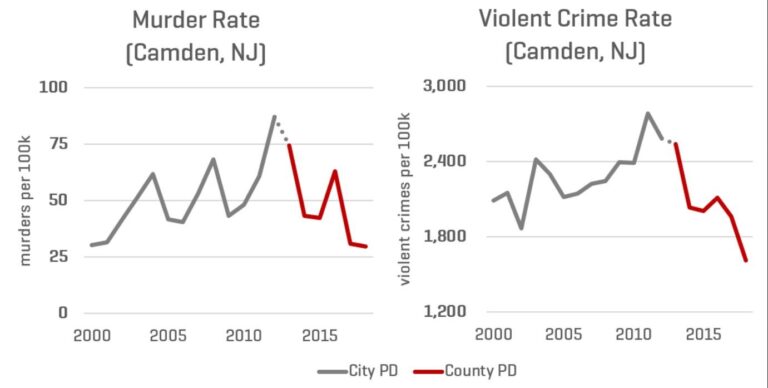Camden, New Jersey: A Comprehensive Look at the Ongoing Decline in Crime Rates
Steady Reduction in Crime Reflects Community and Law Enforcement Synergy
Recent statistics from Camden law enforcement agencies confirm a persistent decrease in criminal incidents throughout the city. Once plagued by high crime rates, Camden has transformed into a safer urban area thanks to robust community engagement and innovative policing methods. Initiatives such as neighborhood watch groups, expanded youth programs, and strengthened partnerships between police and residents have been instrumental in this positive shift. These efforts not only reduce crime but also cultivate a sense of shared responsibility among citizens.
Primary Drivers Behind the Crime Reduction:
- Community-Oriented Policing: Officers actively collaborating with locals to foster trust and swiftly resolve concerns.
- Youth Empowerment Initiatives: Programs offering mentorship and after-school activities to provide alternatives to delinquency.
- Advanced Surveillance and Targeted Patrols: Deployment of technology and increased presence in vulnerable neighborhoods.
| Crime Category | 2022 Incidents | 2023 Incidents | Percentage Change |
|---|---|---|---|
| Violent Crimes | 1,200 | 980 | -18.3% |
| Property Crimes | 3,450 | 2,970 | -13.9% |
| Drug-Related Offenses | 780 | 670 | -14.1% |
Unpacking the Multifaceted Approach to Camden’s Safer Streets
The remarkable progress in Camden’s public safety stems from a comprehensive strategy that integrates community involvement with tactical law enforcement. Authorities have emphasized nurturing trust between police officers and residents, which has led to more effective crime prevention. Regular foot patrols and community policing have enabled officers to gain deeper insights into neighborhood issues, allowing for timely interventions.
Key Elements Fueling Camden’s Crime Reduction:
- Robust investment in education and youth engagement to deter gang affiliation
- Efforts to rehabilitate neglected properties and beautify neighborhoods
- Utilization of data analytics to pinpoint and address crime hotspots
- Partnerships with social service agencies to confront underlying problems like addiction and homelessness
| Initiative | Effectiveness |
|---|---|
| Heightened Police Visibility | 22% decrease in violent crime |
| Youth Engagement Programs | 15% reduction in juvenile delinquency |
| Neighborhood Renewal Projects | Enhanced community perception and safety |
| Data-Driven Policing | Optimized deployment of resources |
Evaluating the Role of Law Enforcement Innovations in Camden’s Crime Decline
The decline in Camden’s crime statistics is largely credited to forward-thinking law enforcement strategies tailored to the city’s specific challenges. Central to this success is the adoption of community policing, which fosters mutual respect and cooperation between officers and residents. This approach has enhanced intelligence gathering and enabled preemptive action against potential criminal activity.
Technological advancements such as predictive analytics and enhanced surveillance have further empowered the police force. By analyzing crime trends, law enforcement can allocate resources more effectively, focusing on repeat offenders and high-risk zones. Collaborative efforts with social services addressing mental health and substance abuse have also been pivotal in reducing recidivism and supporting vulnerable populations.
Below is a summary of key strategies implemented since 2018 and their measurable impacts:
| Strategy | Year Introduced | Crime Reduction (%) | Primary Outcome |
|---|---|---|---|
| Community Policing | 2018 | 25% | Strengthened community trust and cooperation |
| Predictive Crime Analytics | 2019 | 18% | More strategic resource deployment |
| Youth Engagement Initiatives | 2020 | 15% | Prevention through active youth involvement |
| Mental Health Partnerships | 2021 | 12% | Lower rates of repeat offenses |
Strategies to Sustain and Amplify Camden’s Crime Reduction Momentum
To ensure the continued downward trajectory of crime in Camden, it is essential for city officials and community leaders to deepen collaborative efforts that actively involve residents in safety initiatives. Strengthening community policing programs remains a cornerstone, as it builds mutual trust and encourages citizens to participate in crime prevention. Expanding youth mentorship and educational opportunities is equally critical to address socioeconomic factors that often lead to criminal behavior.
Incorporating advanced technology and data analytics will further enhance law enforcement’s ability to deploy resources efficiently and anticipate emerging threats. Camden stands to benefit from adopting smart surveillance systems and predictive policing models that prioritize early intervention. The following recommendations outline key actions for maintaining and advancing public safety gains:
- Boost community engagement through regular town hall meetings and partnerships with local organizations.
- Expand youth mentorship and vocational training to provide constructive pathways.
- Utilize data-driven policing to focus patrols and interventions where they are most needed.
- Increase investment in social services targeting addiction, mental health, and homelessness.
- Enhance urban infrastructure such as improved street lighting and environmental design to deter criminal activity.
| Recommendation | Anticipated Benefit |
|---|---|
| Community Policing & Trust Building | Increased crime reporting and community cooperation |
| Youth Outreach Programs | Lower juvenile crime rates and reduced recidivism |
| Technology-Enhanced Patrols | More effective use of police resources |
| Social Service Investments | Addressing root causes of criminal behavior |
Summary and Outlook
Data from recent years clearly indicate a meaningful decline in crime across Camden, New Jersey, signaling that the city’s comprehensive approach to public safety is bearing fruit. While challenges persist, the positive trends underscore the value of community-centered policing and targeted investments in local resources. Ongoing vigilance, adaptive strategies, and sustained collaboration will be vital to preserving and building upon these gains in the future.








